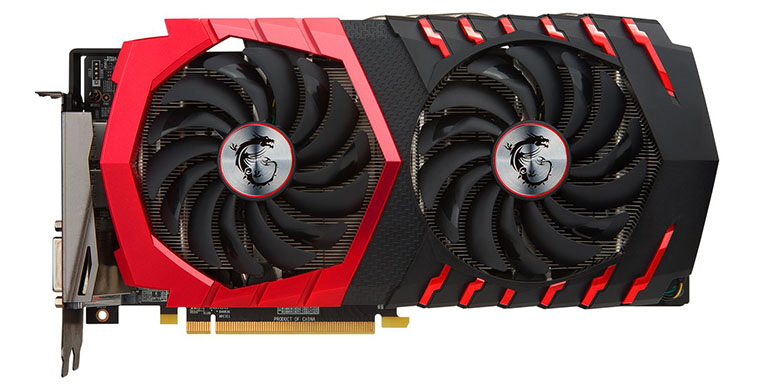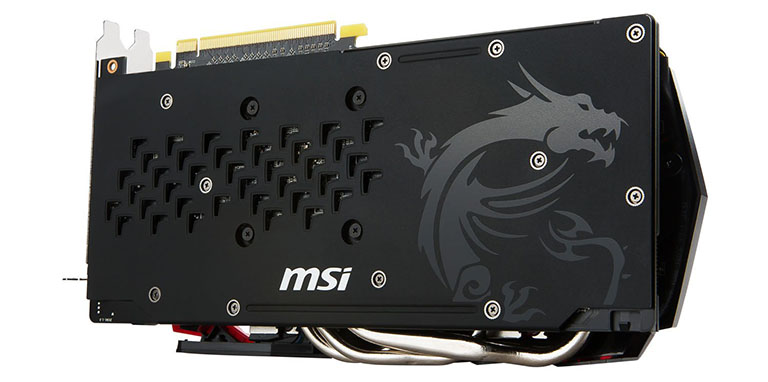Introduction
The AMD Radeon RX 580 has been launched to catalyse interest in the lull between the red team's Polaris and Vega GPU architectures. Essentially an overclocked RX 480 card in all but name, AMD and its add-in board (AIB) partners target gamers who play at high-framerate 1080p, or 1440p with the preferred 60Hz refresh rate. At the time of writing, RX 580 GPU stock is in constraint, hampered by generally low volume in the market that has, in recent months, been taken up by cryptocurrency miners with glee. You'd do well to find many RX 580 8GB cards on the south side of £300, in stock, any time soon.
Such thinking hasn't perturbed the likes of MSI, who continues to build on the good work established by recent cards. It is no surprise to see this model equipped with Twin Frozr VI technology, meaning two 100mm fans attached to a card-wide cooling solution that is built like the proverbial tank.
The card is outwardly identical to the RX 480 model, a revelation that should come as no surprise as MSI seeks to reduce the transition time and cost associated with changing models.
Measuring 276mm long, 140mm tall - so significantly taller than the traditional bracket - and 42mm thick, MSI deals with the RX 580 GPU through a mixture of mass and size. Whereas the competing GeForce GTX 1060 GPUs tend to small, this near-1kg card could, at first glance, be mistaken for a GeForce GTX 1080 Ti, such is the bulk.
MSI continues to use a zero-fan mode where the twin spinners don't activate until temperature hits 60°C, and the design of the fans is such that they have two types of blades: a steeper-angle dispersion and a traditional blade. You can see that both fans' blades follow a dispersion/traditional pattern. MSI claims these Torx 2.0 fans offer more airflow at a lower volume than going traditional alone.
The backplate, too, is built nicely and becomes warm to the touch when under load. The cooling isn't wholly enclosed, though, and MSI has a couple of heatpipes snaking out of the bottom. Another backplate is situated between the GPU and heatsink on the top side and it cools the VRMs and memory by being directly attached to them.
A side-on shot shows what is going on, and it is interesting to see that MSI uses a single 8-pin power connector, offering a total of 225W to the card once the PCIe slot is taken into account. A standard RX 580 pulls 185W under load, according to AMD, so this overclocked variant gets close to the maximum provided by the single power plug.
Speaking of numbers and in common with other MSI cards, the RX 580 8GB Gaming X has three sets of speeds. Out of the box the card should be set to Gaming Mode, clocking in at 1,380MHz core and 8,000MHz memory for the 8GB of VRAM. OC Mode elevates these to 1,393/8,100MHz while Silent Mode drops to 1,340/8,000MHz. Our sample, direct from MSI, was configured in OC Mode, and we had to use the Gaming App to reduce it to the regular Gaming Mode speeds.
The same Gaming App controls the inevitable RGB lighting present here, available on the side logo and, in red alone, across the 'thunder' markings on the heatsink. The effect is decent and works especially well if you have other MSI hardware in the rig. This card is available as a model equipped with 4GB, too, reducing the cost by approximately £40.
Keeping consistency amongst generations, we have two DisplayPort, two HDMI and good old DVI-D. A lack of supply and continued demand from cryptocurrency miners elevates the real-world cost to £350, or way above the £230 or so charged for last year's RX 480 8GB on its release. Let's now fire up the benchmarks.













